First High-Power CSEM Field Test in Saudi Arabia
Abstract
:1. Introduction
2. Geological Setting of the Study Area
3. Methodology
3.1. Data Acquisition
3.2. Data Processing
4. Results
5. Conclusions
Author Contributions
Funding
Institutional Review Board Statement
Informed Consent Statement
Data Availability Statement
Acknowledgments
Conflicts of Interest
References
- Vozoff, K. 8. The Magnetotelluric Method. In Electromagnetic Methods in Applied Geophysics; Society of Exploration Geophysicists: Houston, TX, USA, 1991; pp. 641–712. [Google Scholar]
- Colombo, D.; McNeice, G.; Curiel, E.S.; Fox, A. Full tensor CSEM and MT for subsalt structural imaging in the Red Sea: Implications for seismic and electromagnetic integration. Lead. Edge 2013, 32, 436–449. [Google Scholar] [CrossRef]
- Colombo, D.; Keho, T.; McNeice, G. Integrated seismic-electromagnetic workflow for sub-basalt exploration in northwest Saudi Arabia. Lead. Edge 2012, 31, 42–52. [Google Scholar] [CrossRef]
- Colombo, D.; Dasgupta, S.; Strack, K.M.; Yu, G. Results of Feasibility Study of Surface-to-Borehole Time-Domain CSEM for Water-Oil Fluid Substitution in Ghawar Field, Saudi Arabia. In Proceedings of the GEO 2010, Manama, Bahrain, 7–10 March 2010. [Google Scholar]
- Sheard, S.N.; Ritchie, T.J.; Christopherson, K.R.; Brand, E. Mining, Environmental, Petroleum, and Engineering Industry Applications of Electromagnetic Techniques in Geophysics. Surv. Geophys. 2005, 26, 653–669. [Google Scholar] [CrossRef]
- Strack, K.M. Future Directions of Electromagnetic Methods for Hydrocarbon Applications. Surv. Geophys. 2014, 35, 157–177. [Google Scholar] [CrossRef]
- Streich, R. Controlled-Source Electromagnetic Approaches for Hydrocarbon Exploration and Monitoring on Land. Surv. Geophys. 2016, 37, 47–80. [Google Scholar] [CrossRef]
- Tietze, K.; Ritter, O.; Veeken, P. Controlled-source electromagnetic monitoring of reservoir oil saturation using a novel borehole-to-surface configuration. Geophys. Prospect. 2015, 63, 1468–1490. [Google Scholar] [CrossRef]
- Henke, C.H.; Krieger, M.H.; Strack, K.; Zerilli, A. Subsalt imaging in northern Germany using multiphysics (magnetotellurics, gravity, and seismic). Interpretation 2020, 8, SQ15–SQ24. [Google Scholar] [CrossRef]
- Strack, K.; Davydycheva, S.; Hanstein, T.; Smirnov, M. A new array system for multiphysics (MT, LOTEM, and microseismics) with focus on reservoir monitoring. AIP Conf. Proc. 2017, 1861, 020001. [Google Scholar]
- Hu, W.; Yan, L.; Su, Z.; Zheng, R.; Strack, K. Array TEM sounding and application for reservoir monitoring. In Proceedings of the SEG Technical Program Expanded Abstracts 2008; Society of Exploration Geophysicists: Houston, TX, USA, 2008; pp. 634–638. [Google Scholar]
- Demirci, İ.; Dikmen, Ü.; Candansayar, M.E. Two-dimensional joint inversion of Magnetotelluric and local earthquake data: Discussion on the contribution to the solution of deep subsurface structures. Phys. Earth Planet. Inter. 2018, 275, 56–68. [Google Scholar] [CrossRef]
- Davydycheva, S.; Rykhlinski, N. Focused-source EM survey versus time-domain and frequency-domain CSEM. Lead. Edge 2009, 28, 944–949. [Google Scholar] [CrossRef]
- Davydycheva, S.; Rykhlinski, N. Focused-source electromagnetic survey versus standard CSEM: 3D modeling in complex geometries. Geophysics 2011, 76, F27–F41. [Google Scholar] [CrossRef]
- Demirci, İ.; Candansayar, M.E.; Vafidis, A.; Soupios, P. Two dimensional joint inversion of direct current resistivity, radio-magnetotelluric and seismic refraction data: An application from Bafra Plain, Turkey. J. Appl. Geophys. 2017, 139, 316–330. [Google Scholar] [CrossRef]
- Strack, K.; Davydycheva, S. Using Electromagnetics to Map Lateral Fluid Variations in Carbonates in SE Asia. In New Approaches in Engineering Research; Book Publisher International (a part of SCIENCEDOMAIN International): Dulles, Virginia, 2021; Volume 2, pp. 69–79. [Google Scholar]
- Palisch, T.; Al-Tailji, W.; Bartel, L.; Cannan, C.; Zhang, J.; Czapski, M.; Lynch, K. Far-Field Proppant Detection Using Electromagnetic Methods-Latest Field Results. In Proceedings of the SPE Hydraulic Fracturing Technology Conference and Exhibition, The Woodlands, Texas, USA, 24–26 January 2017. [Google Scholar]
- Soupios, P.; Davydycheva, S.; Strack, K. Mapping fluid front in Carbonates using Electromagnetic. In Proceedings of the SPWLA Abu Dhabi Chapter Topical Conference, Reservoir Fluid Surveillance, Today and Beyond, Abu Dhabi, United Arab Emirates, 13–14 December 2021. [Google Scholar]
- Strack, K.; Pandey, P. Exploration with controlled-source electromagnetics under basalt cover in India. Lead. Edge 2007, 26, 360–363. [Google Scholar] [CrossRef]
- Aboud, E.; Wameyo, P.; Alqahtani, F.; Moufti, M.R. Imaging subsurface northern Rahat Volcanic Field, Madinah city, Saudi Arabia, using Magnetotelluric study. J. Appl. Geophys. 2018, 159, 564–572. [Google Scholar] [CrossRef]
- Autio, U.; Smirnov, M.Y.; Savvaidis, A.; Soupios, P.; Bastani, M. Combining electromagnetic measurements in the Mygdonian sedimentary basin, Greece. J. Appl. Geophys. 2016, 135, 261–269. [Google Scholar] [CrossRef]
- Demirci, İ.; Gündoğdu, N.Y.; Candansayar, M.E.; Soupios, P.; Vafidis, A.; Arslan, H. Determination and Evaluation of Saltwater Intrusion on Bafra Plain: Joint Interpretation of Geophysical, Hydrogeological and Hydrochemical Data. Pure Appl. Geophys. 2020, 177, 5621–5640. [Google Scholar] [CrossRef]
- Haroon, A.; Lippert, K.; Mogilatov, V.; Tezkan, B. First application of the marine differential electric dipole for groundwater investigations: A case study from Bat Yam, Israel. Geophysics 2018, 83, B59–B76. [Google Scholar] [CrossRef]
- Panagopoulos, G.; Soupios, P.; Vafidis, A.; Manoutsoglou, E. Integrated use of well and geophysical data for constructing 3D geological models in shallow aquifers: A case study at the Tymbakion basin, Crete, Greece. Environ. Earth Sci. 2021, 80, 142. [Google Scholar] [CrossRef]
- Rani, P.; Soupios, P.; Barsukov, P. Regional tectonic model of Southern, Central part of the Mygdonian basin (Northern Greece) by applying 3D Transient Electromagnetic Modeling. J. Appl. Geophys. 2020, 176, 104008. [Google Scholar] [CrossRef]
- He, Z.; Hu, Z.; Gao, Y.; He, L.; Meng, C.; Yang, L. Field test of monitoring gas reservoir development using time-lapse continuous electromagnetic profile method. Geophysics 2015, 80, WA127–WA134. [Google Scholar] [CrossRef]
- Hördt, A.; Andrieux, P.; Neubauer, F.M.; Rüter, H.; Vozoff, K. A first attempt at monitoring underground gas storage by means of time-lapse multichannel transient electromagnetics. Geophys. Prospect. 2000, 48, 489–509. [Google Scholar] [CrossRef]
- Kalscheuer, T.; Juhojuntti, N.; Vaittinen, K. Two-Dimensional Magnetotelluric Modelling of Ore Deposits: Improvements in Model Constraints by Inclusion of Borehole Measurements. Surv. Geophys. 2018, 39, 467–507. [Google Scholar] [CrossRef]
- Cabello, J. Lithium brine production, reserves, resources and exploration in Chile: An updated review. Ore Geol. Rev. 2021, 128, 103883. [Google Scholar] [CrossRef]
- Wang, D.; Dai, H.; Liu, S.; Wang, C.; Yu, Y.; Dai, J.; Liu, L.; Yang, Y.; Ma, S. Research and exploration progress on lithium deposits in China. China Geol. 2020, 3, 137–152. [Google Scholar] [CrossRef]
- Martinez, Y.; Ashadi, A.; Hinojosa, H.; Soupios, P.; Strack, K. New High-Power Controlled Source Electromagnetic System for Geothermal Applications. In Proceedings of the Geothermal Rise Conference, Reno, NV, USA, 28–31 August 2022. [Google Scholar]
- Tulinius, H.; Ádám, L.; Halldórsdóttir, H.; Yu, G.; Strack, K.; Allegar, N.; He, L.; He, Z. Exploring for geothermal reservoirs using broadband 2-D MT and gravity in Hungary. In Proceedings of the SEG Technical Program Expanded Abstracts 2008; Society of Exploration Geophysicists: Houston, TX, USA, 2008; pp. 1147–1151. [Google Scholar]
- Tulinius, H.; Ádám, L.; Strack, K.M.; Yu, G.; He, L.F. Geothermal Exploration Using Integrated 2-D MT and Gravity Surveys in Hungary. In Proceedings of the 70th EAGE Conference and Exhibition Incorporating SPE EUROPEC 2008, Rome, Italy, 9–12 June 2008. [Google Scholar]
- Barajas-Olalde, C.; Davydycheva, S.; Hanstein, T.; Laudal, D.; Martinez, Y.; MacLennan, K.; Mikula, S.; Adams, D.C.; Klapperich, R.J.; Peck, W.D. Using controlled-source electromagnetic (CSEM) for CO2 storage monitoring in the North Dakota CarbonSAFE project. In Proceedings of the First International Meeting for Applied Geoscience & Energy Expanded Abstracts, Houston, TX, USA, 26 September–1 October 2021; pp. 503–507. [Google Scholar]
- Champion, D. Australian Resource Review: Lithium 2018; Geoscience Australia: Canberra, Australia, 2019; ISBN 978-1-925848-28-1. [Google Scholar]
- Curcio, A.; Chanampa, E.; Cabanillas, L.; Piethe, R. An effective multiphysics toolkit for Lithium prospecting: From geophysics to the static reservoir model in Pozuelos salt flat, Argentina. In Proceedings of the The International Meeting for Applied Geoscience & Energy (IMAGE2022), Houston, TX, USA, 28 August–1 September 2022. [Google Scholar]
- Curcio, A. President’s Page: Resources and geophysical opportunities in South America. Lead. Edge 2022, 41, 228–229. [Google Scholar] [CrossRef]
- Tleel, J.W. Surface Geology of Dammam Dome, Eastern Province, Saudi Arabia. Am. Assoc. Pet. Geol. Bull. 1973, 57, A4304–A4316. [Google Scholar]
- Weijermars, R. Quaternary Evolution of Dawhat Zulum (Half Moon Bay) Region Eastern Province, Saudi Arabia. GeoArabia 1999, 4, 71–90. [Google Scholar]
- Weijermars, R. Surface Geology, Lithostratigraphy and Tertiary Growth of the Dammam Dome, Saudi Arabia: A New Field Guide. GeoArabia 1999, 4, 199–226. [Google Scholar] [CrossRef]
- Seber, D.; Steer, D.; Sandvol, E.; Sandvol, C.; Brindisi, C.; Barazangi, M. Design and Development of Information Systems for the Geosciences: An Application to the Middle East. GeoArabia 2000, 5, 269–296. [Google Scholar] [CrossRef]
- Strack, K.M.; Martinez, Y.L.; Passalacqua, H.; Xu, X. Cloud-Based Array Electromagnetics Contributing to Zero Carbon Footprint. In Proceedings of the Off-Shore Technology Conference; OTC: Houston, TX, USA, 2022. [Google Scholar]
- Davydycheva, S.; Rykhlinski, N.; Legeido, P. Electrical-prospecting method for hydrocarbon search using the induced-polarization effect. Geophysics 2006, 71, G179–G189. [Google Scholar] [CrossRef]
- Claerbout, J.F. Fundamentals of Geophysical Data Processing with Applications to Petroleum Prospecting; Blackwell Science Inc.: Osney Mead, Oxford, UK, 1985; ISBN 978-0865423053. [Google Scholar]
- Strack, K. Exploration with Deep Transient Electromagnetics; Elsevier: Amsterdam, The Netherands, 1992; ISBN 978-0444895417. [Google Scholar]
- Zhdanov, M.S. Magnetotelluric and Magnetovariational Methods. In Foundations of Geophysical Electromagnetic Theory and Methods; Elsevier: Amsterdam, The Netherands, 2018; pp. 495–584. [Google Scholar]
- Siripunvaraporn, W.; Egbert, G. An efficient data-subspace inversion method for 2-D magnetotelluric data. Geophysics 2000, 65, 791–803. [Google Scholar] [CrossRef]
- Pedersen, L.B.; Engels, M. Routine 2D inversion of magnetotelluric data using the determinant of the impedance tensor. Geophysics 2005, 70, G33–G41. [Google Scholar] [CrossRef]
- Berdichevsky, M.; Dimitriev, V. Basic Principles of Interpretation of Magnetotelluric Sounding Curves. In Geolelectric and Geothermal Studies; Adam, A., Ed.; KAPG Geophysical Monograph, Akademiai Kaido: Budapest, Hungary, 1976; pp. 165–221. [Google Scholar]
- Smirnov, M.Y.; Pedersen, L.B. Magnetotelluric measurements across the Sorgenfrei-Tornquist Zone in southern Sweden and Denmark. Geophys. J. Int. 2009, 176, 443–456. [Google Scholar] [CrossRef]
- Falcon-Suarez, I.; Marín-Moreno, H.; Browning, F.; Lichtschlag, A.; Robert, K.; North, L.J.; Best, A.I. Experimental assessment of pore fluid distribution and geomechanical changes in saline sandstone reservoirs during and after CO2 injection. Int. J. Greenh. Gas. Control 2017, 63, 356–369. [Google Scholar] [CrossRef]
- Houston, J.; Butcher, A.; Ehren, P.; Evans, K.; Godfrey, L. The Evaluation of Brine Prospects and the Requirement for Modifications to Filing Standards. Econ. Geol. 2011, 106, 1225–1239. [Google Scholar] [CrossRef]
- Bradley, D.; Munk, L.A.; Jochens, H.; Hynek, S.A.; Labay, K. A Preliminary Deposit Model for Lithium Brines; US Department of the Interior, US Geological Survey: Reston, VA, USA, 2013. [Google Scholar]
- Munk, L.A.; Hynek, S.A.; Bradley, D.C.; Boutt, D.; Labay, K.; Jochens, H. Lithium Brines A Global Perspective. In Rare Earth and Critical Elements in Ore Deposits; Society of Economic Geologists: Littleton, CO, USA, 2016; pp. 339–365. [Google Scholar]
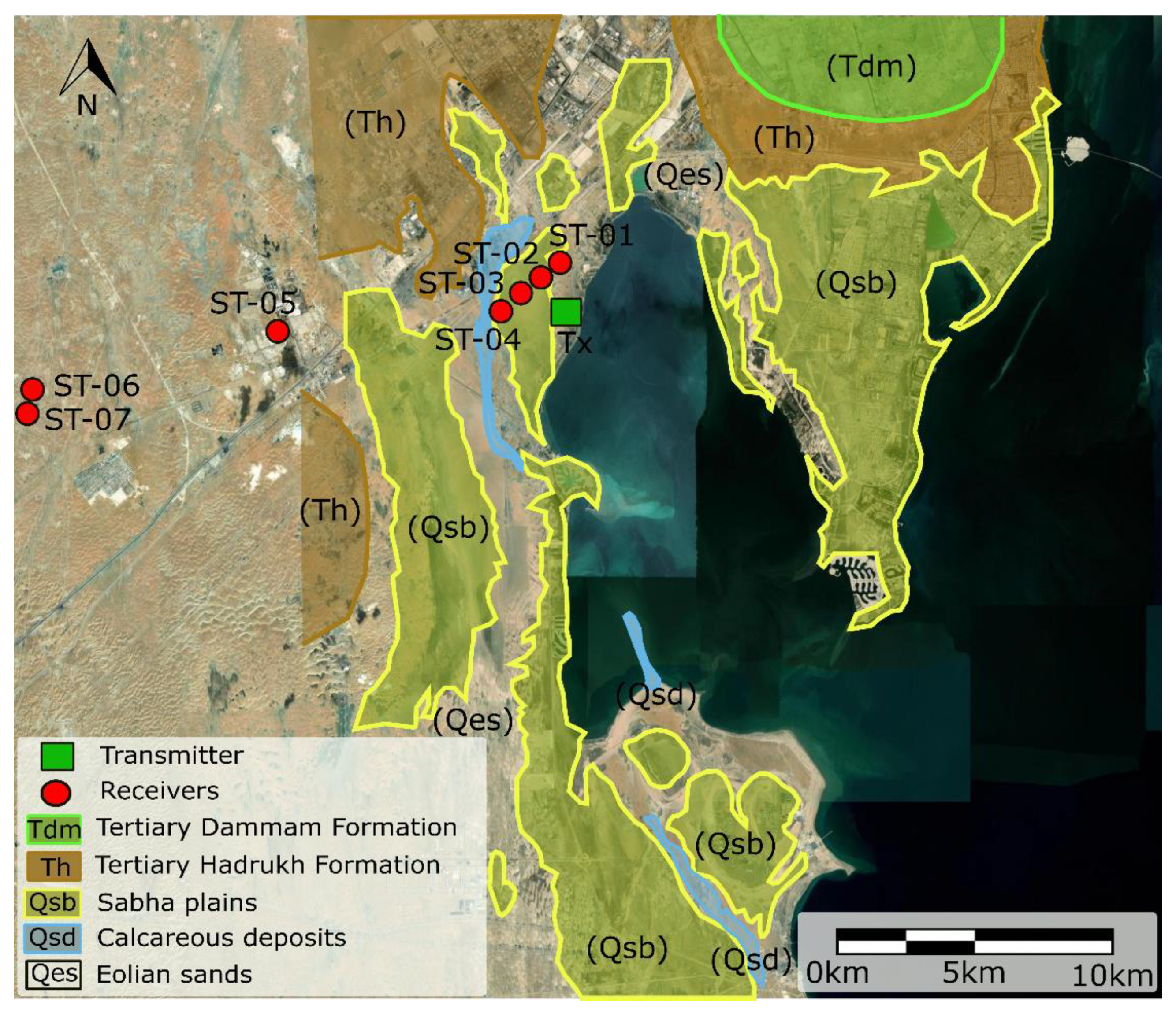
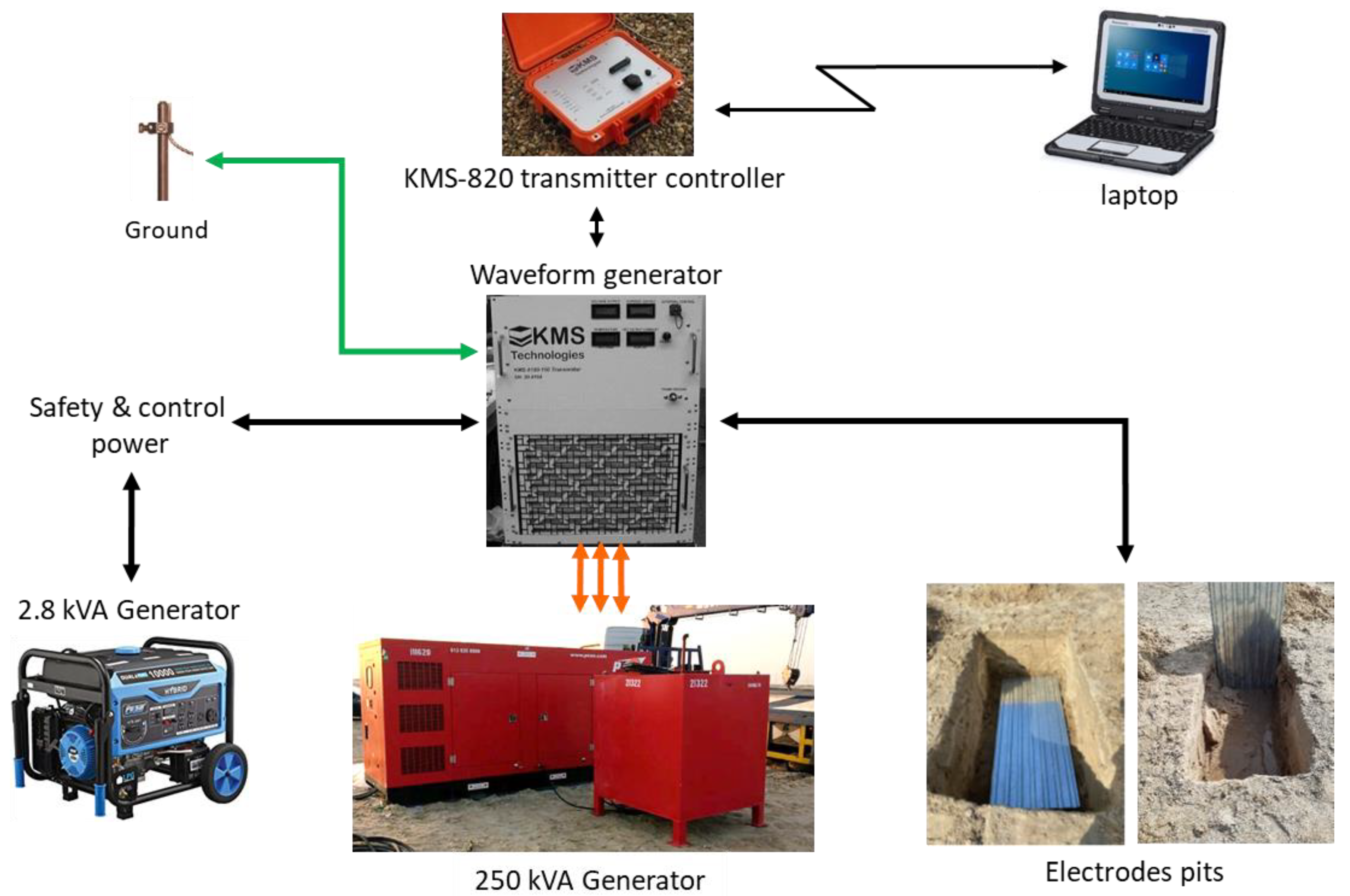

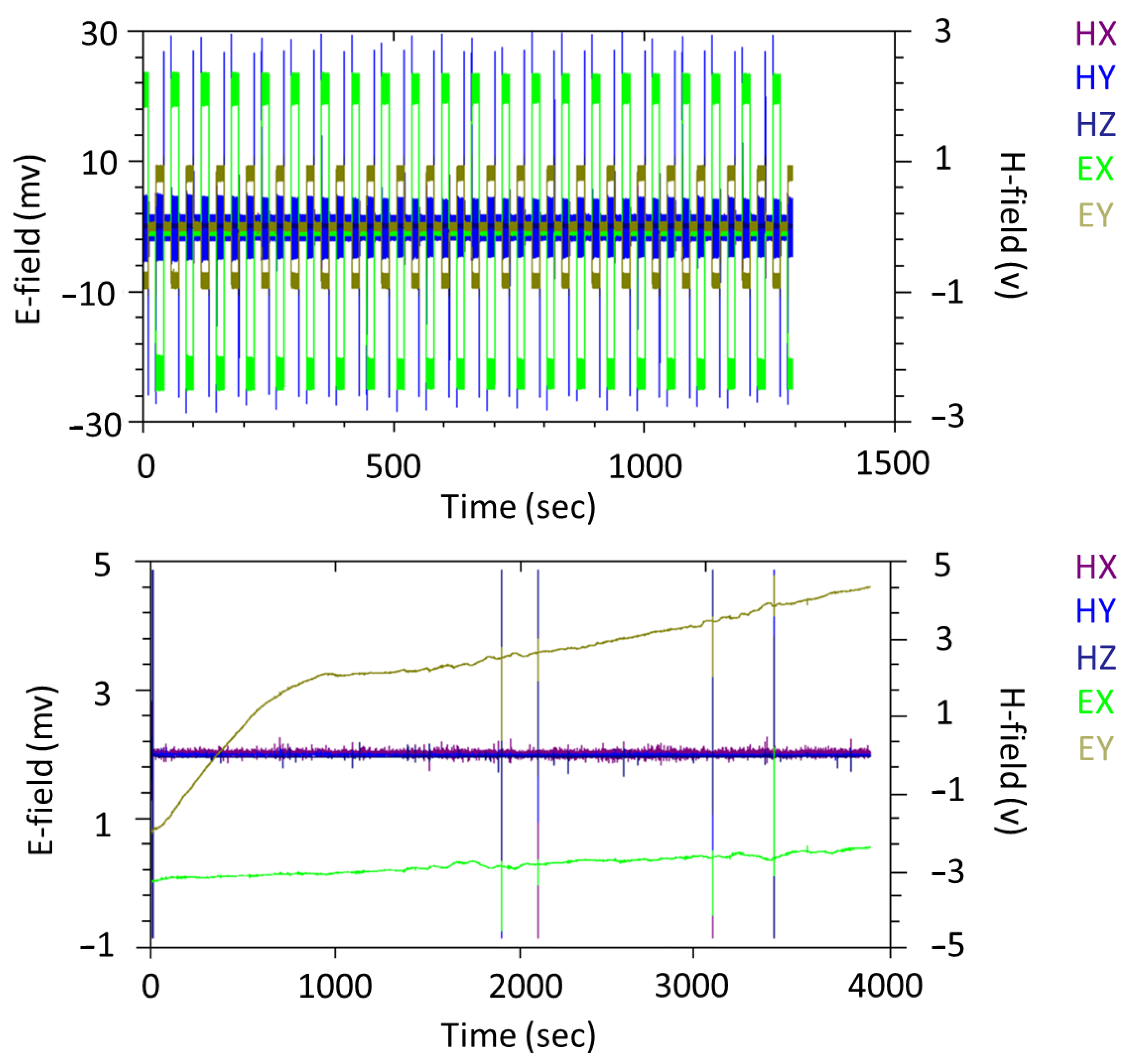
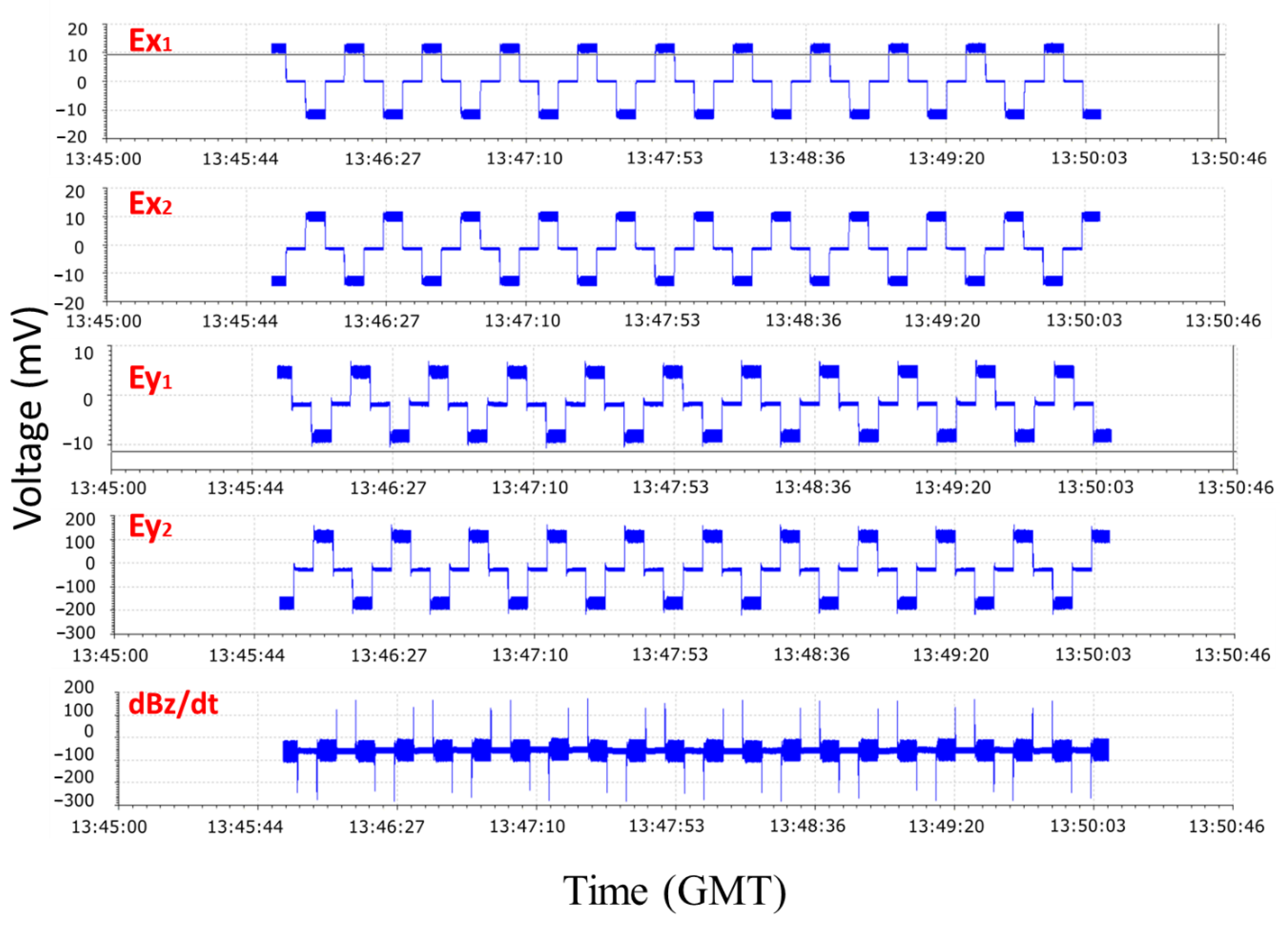
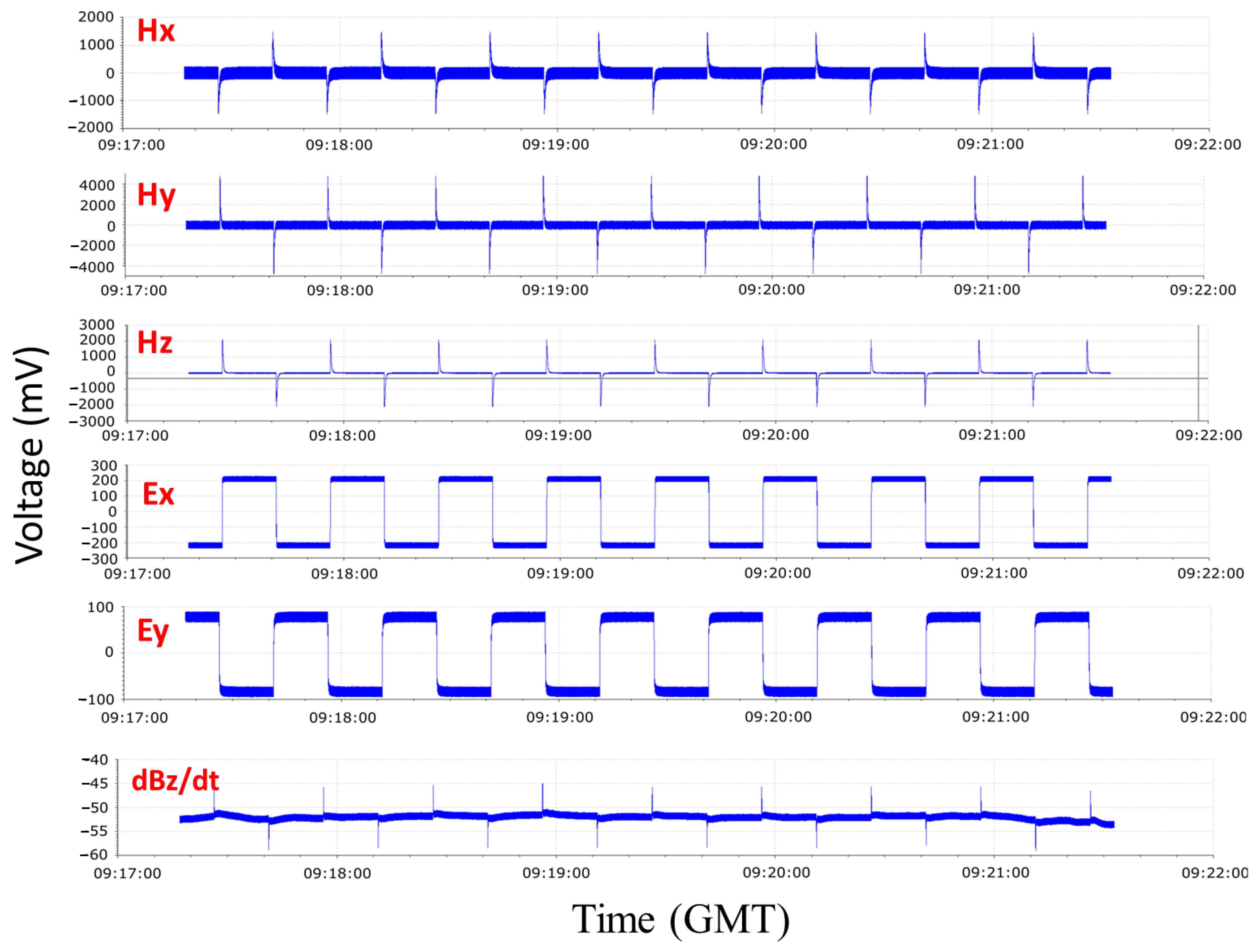

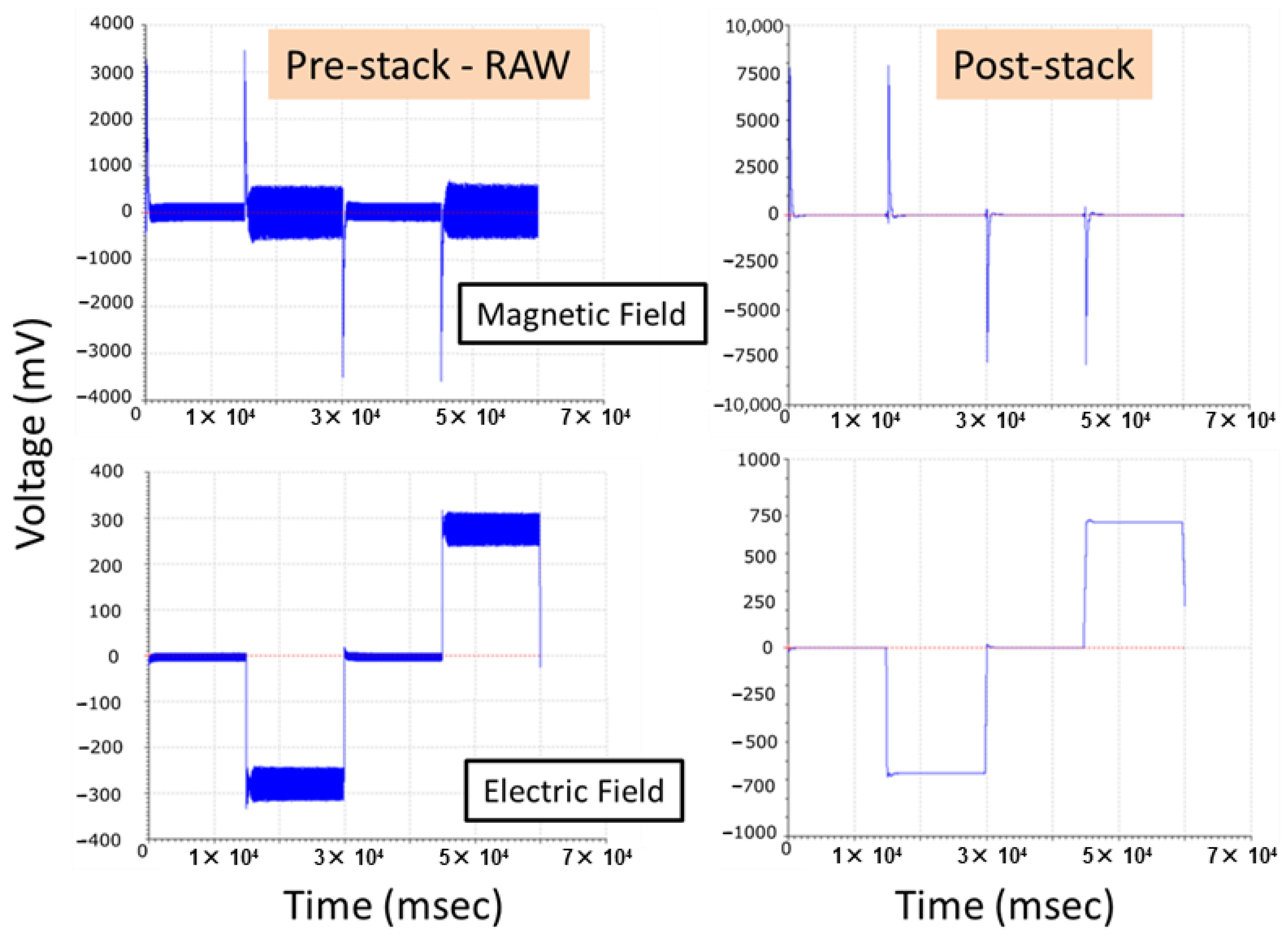
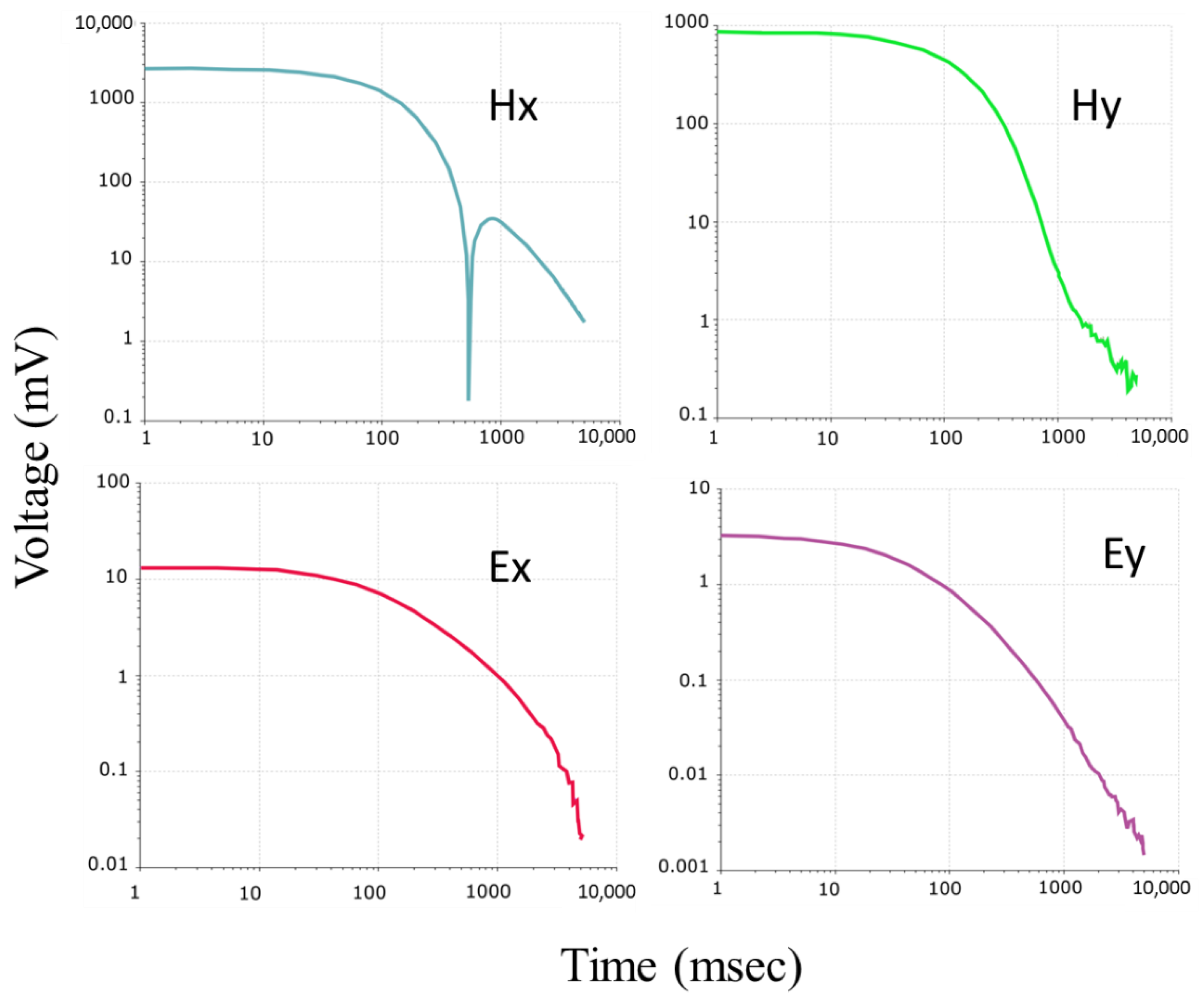
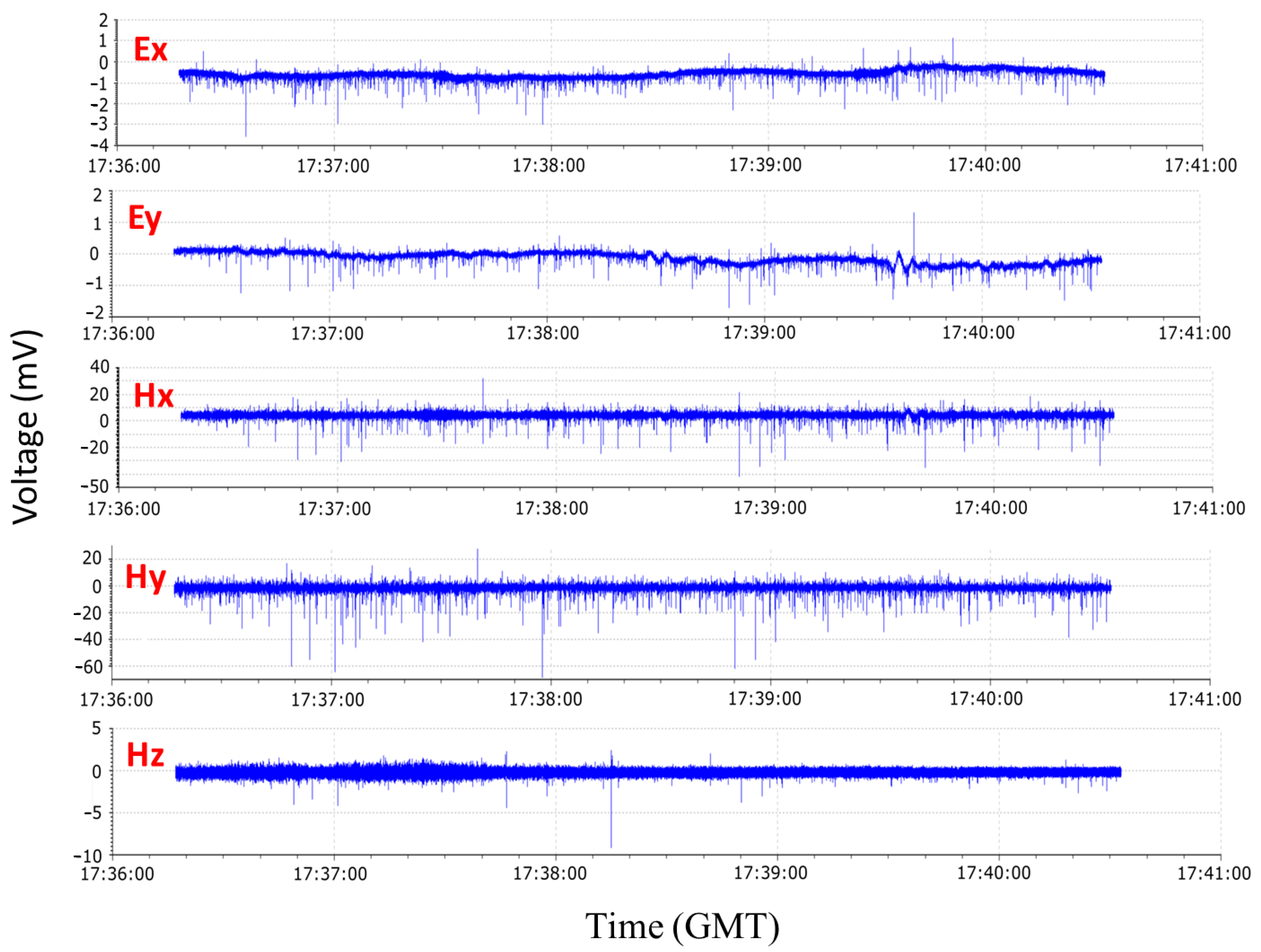
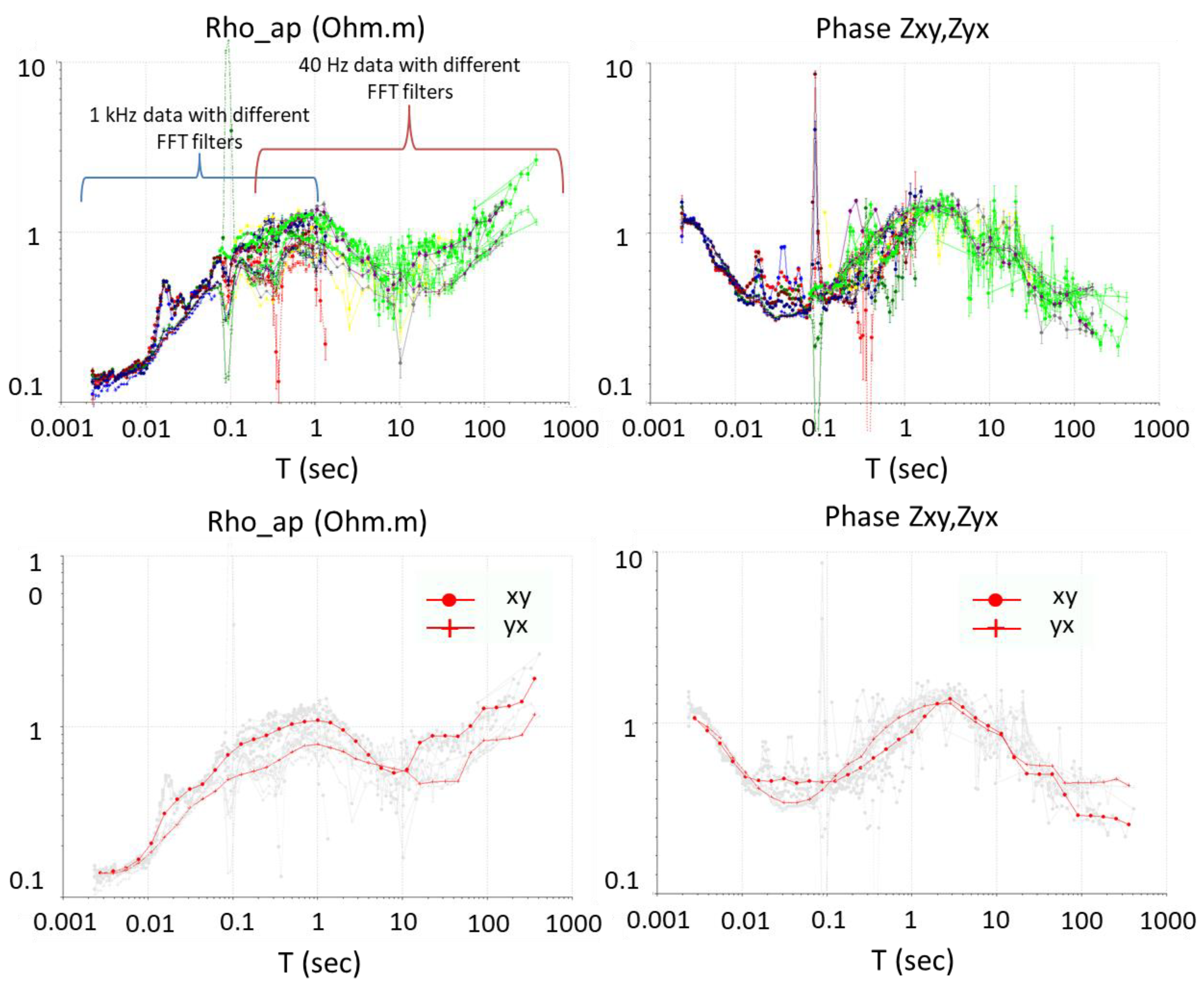
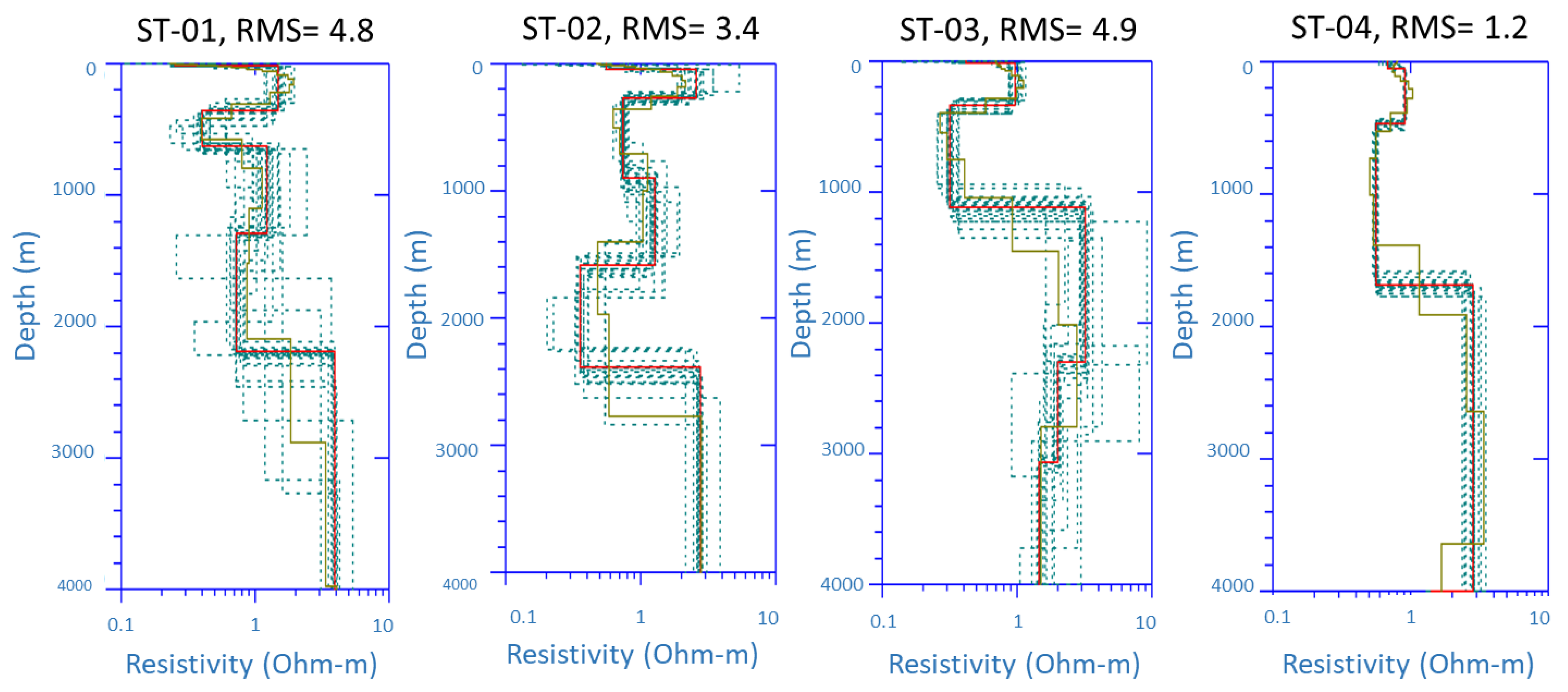
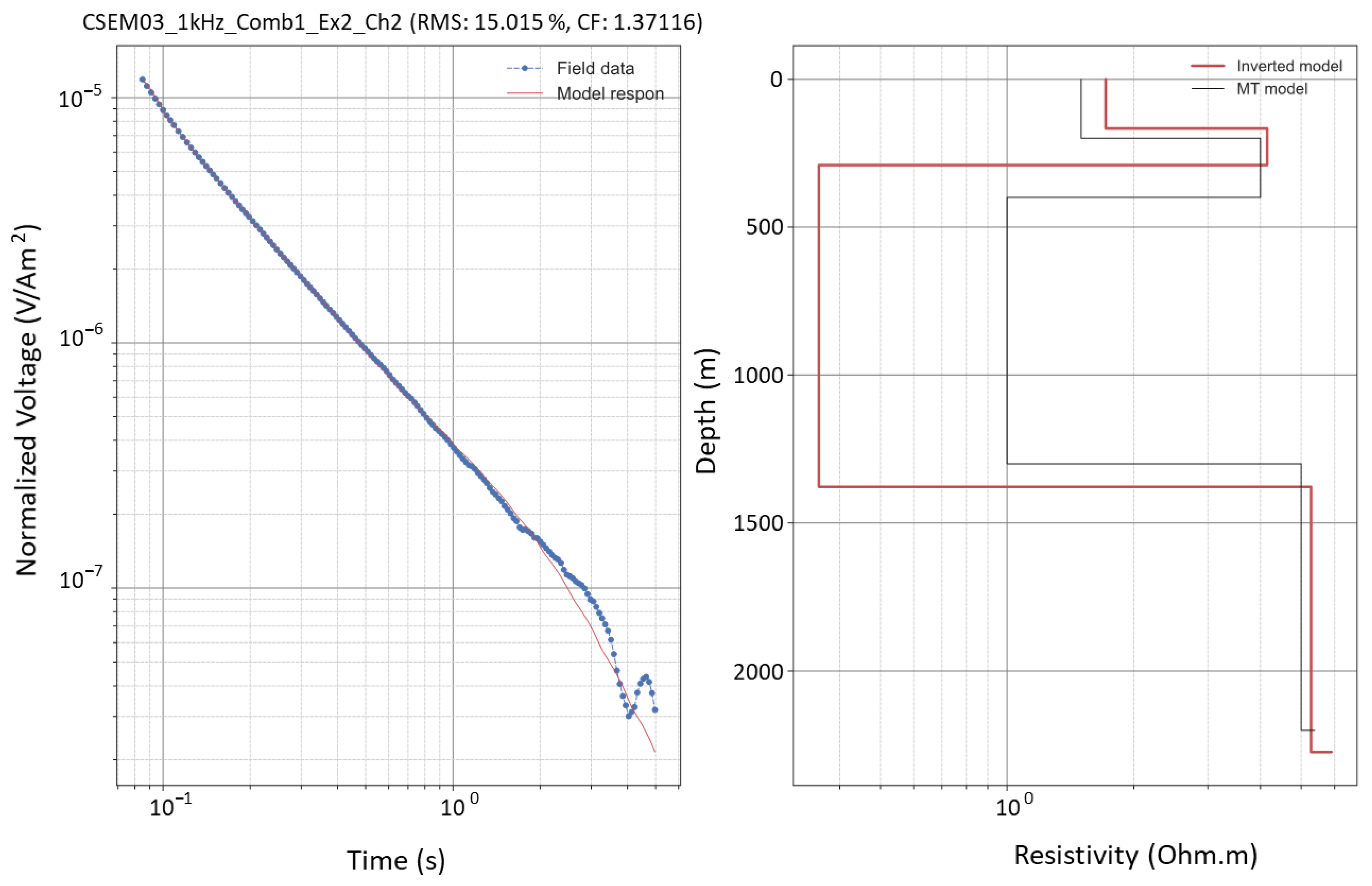
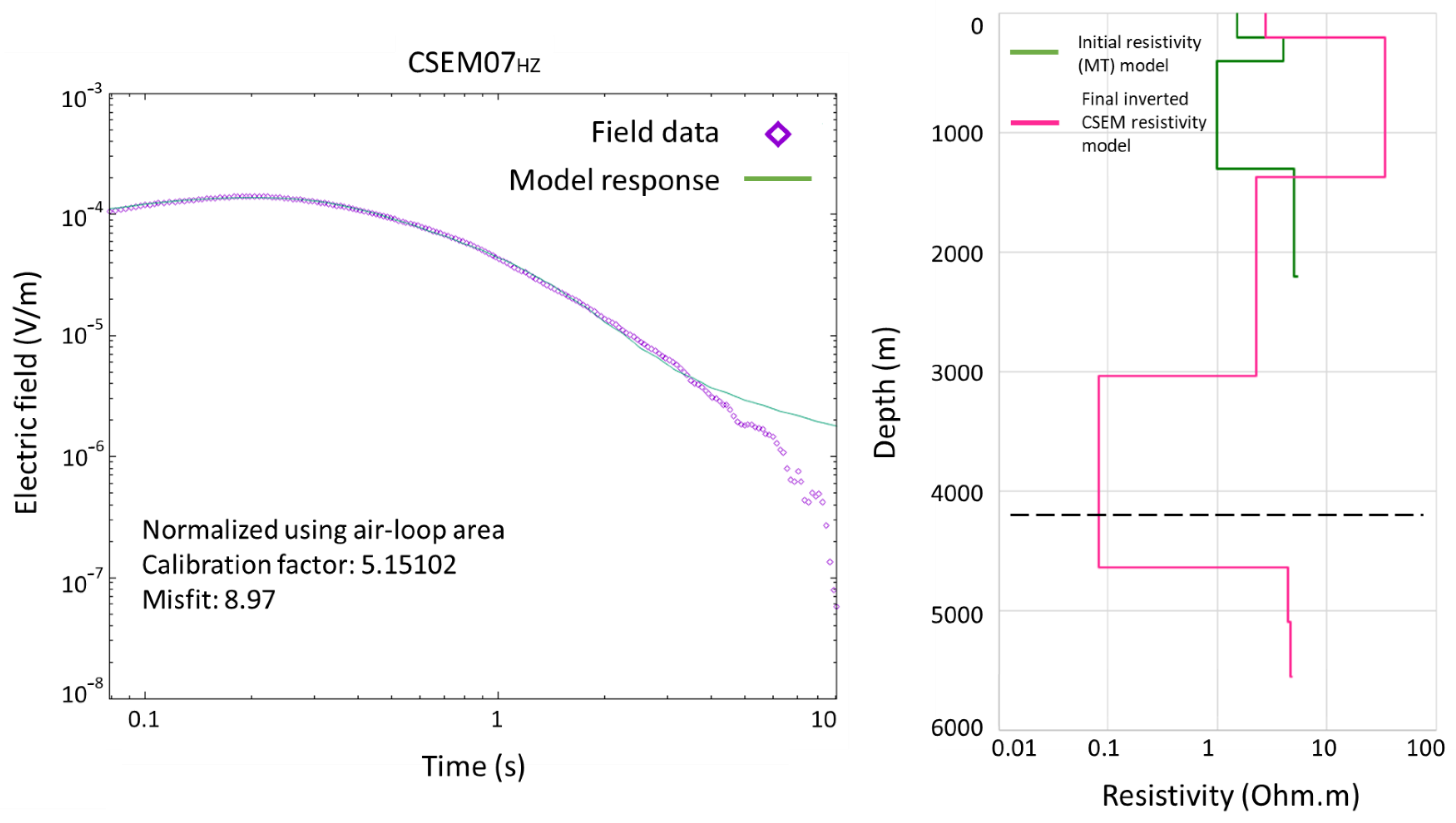
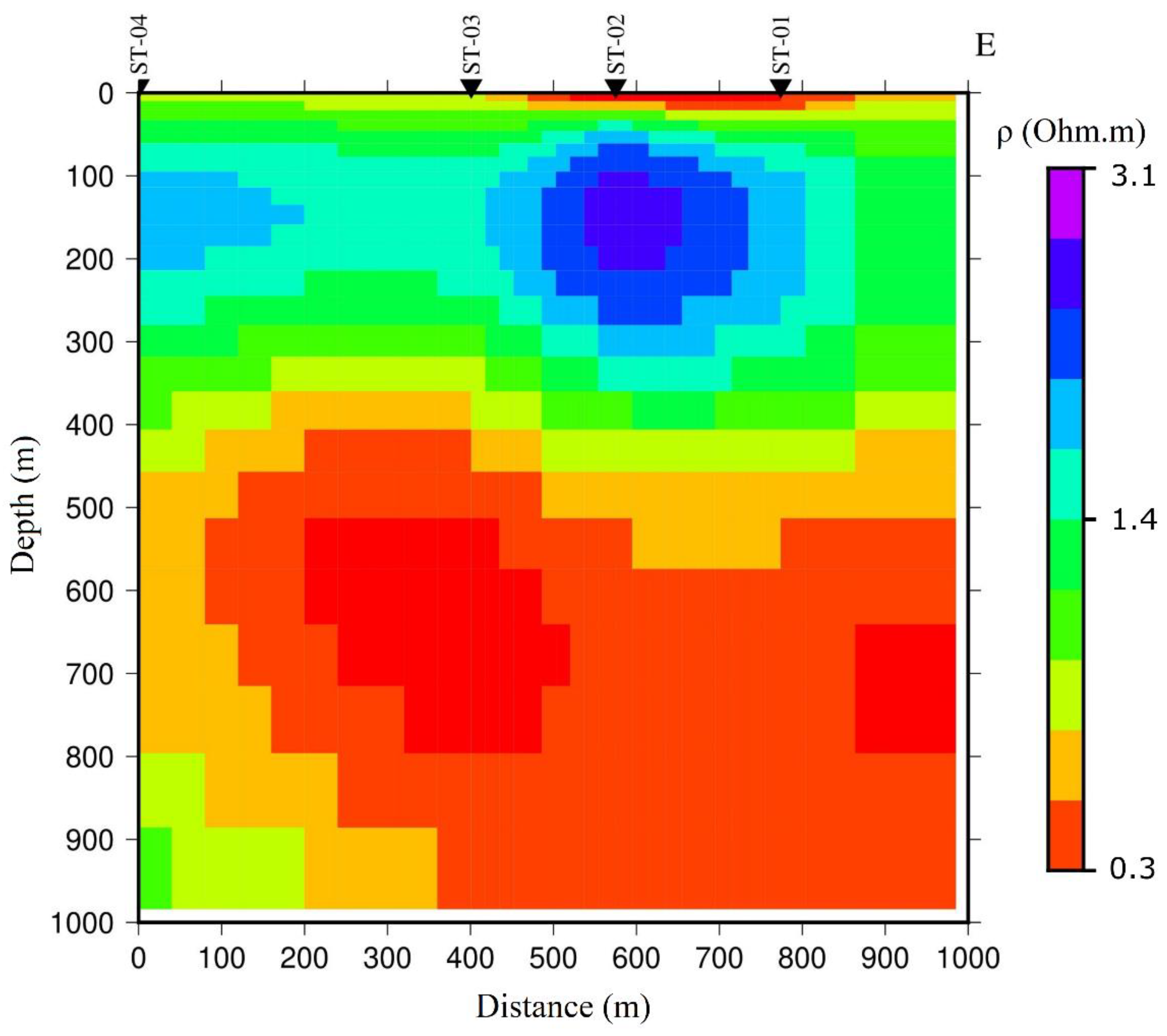
| Station | Coordinates | Elevation (m) | Distance from Tx (m) |
|---|---|---|---|
| ST-01 | 26°09.4489′ N 49°59.4567′ E | 0 | 931 |
| ST-02 | 26°09.4057′ N 49°59.3446′ E | 0 | 1005 |
| ST-03 | 26°09.3652′ N 49°59.2511′ E | 0 | 1092 |
| ST-04 | 26°09.2756′ N 49°59.0329′ E | 0 | 1357 |
| ST-05 | 26°08.6684′ N 49°53.4044′ E | 3 | 10,700 |
| ST-06 | 26°07.0260′ N 49°47.6663′ E | 44 | 20,584 |
| ST-07 | 26°06.8866′ N 49°47.5993′ E | 44 | 20,736 |
| Station | Day 1 (Tx Test and MT) | Day 2 (CSEM and MT) | Day 3 (CSEM and MT) | Day 4 (CSEM and MT) |
|---|---|---|---|---|
| ST-01 | STD MT | LOTEM | STD MT, LOTEM, S20 | STD MT, S20 |
| ST-02 | STD MT | STD MT, S20 | STD MT, S20 | STD MT, S20 |
| ST-03 | FSEM, STD MT | STD MT, S20 | STD MT, S20 | STD MT, S20 |
| ST-04 | FSEM, STD MT | LOTEM | STD MT, LOTEM, S20 | STD MT, S20 |
| ST-05 | - | - | - | LOTEM |
| ST-06 | - | - | - | LOTEM |
| ST-07 | - | - | - | STD MT, LOTEM |
Publisher’s Note: MDPI stays neutral with regard to jurisdictional claims in published maps and institutional affiliations. |
© 2022 by the authors. Licensee MDPI, Basel, Switzerland. This article is an open access article distributed under the terms and conditions of the Creative Commons Attribution (CC BY) license (https://creativecommons.org/licenses/by/4.0/).
Share and Cite
Ashadi, A.L.; Martinez, Y.; Kirmizakis, P.; Hanstein, T.; Xu, X.; Khogali, A.; Paembonan, A.Y.; AlShaibani, A.; Al-Karnos, A.; Smirnov, M.; et al. First High-Power CSEM Field Test in Saudi Arabia. Minerals 2022, 12, 1236. https://doi.org/10.3390/min12101236
Ashadi AL, Martinez Y, Kirmizakis P, Hanstein T, Xu X, Khogali A, Paembonan AY, AlShaibani A, Al-Karnos A, Smirnov M, et al. First High-Power CSEM Field Test in Saudi Arabia. Minerals. 2022; 12(10):1236. https://doi.org/10.3390/min12101236
Chicago/Turabian StyleAshadi, Abdul Latif, Yardenia Martinez, Panagiotis Kirmizakis, Tilman Hanstein, Xiayu Xu, Abid Khogali, Andri Yadi Paembonan, Ahmed AlShaibani, Assem Al-Karnos, Maxim Smirnov, and et al. 2022. "First High-Power CSEM Field Test in Saudi Arabia" Minerals 12, no. 10: 1236. https://doi.org/10.3390/min12101236
APA StyleAshadi, A. L., Martinez, Y., Kirmizakis, P., Hanstein, T., Xu, X., Khogali, A., Paembonan, A. Y., AlShaibani, A., Al-Karnos, A., Smirnov, M., Strack, K., & Soupios, P. (2022). First High-Power CSEM Field Test in Saudi Arabia. Minerals, 12(10), 1236. https://doi.org/10.3390/min12101236








